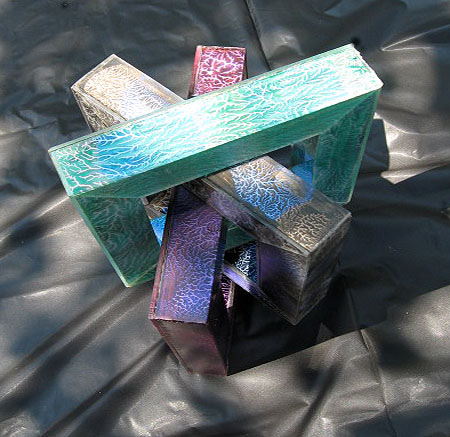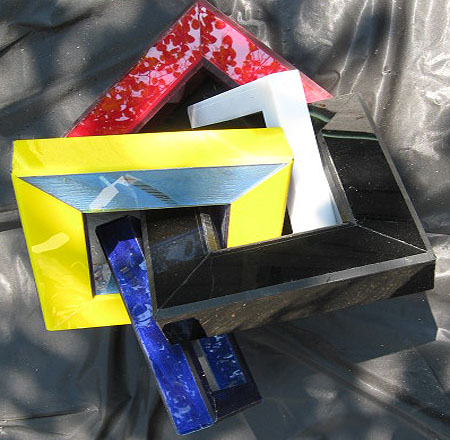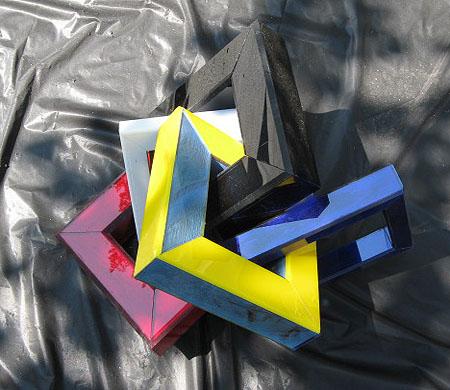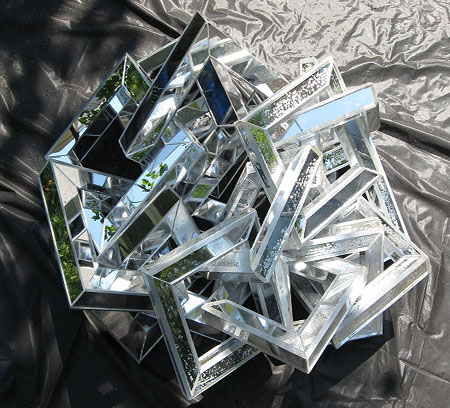In answer to some real physical issues and intrigued by the visual possibilities, I have been experimenting with plastic as a medium for making chains. Acrylic plastic is tough and I have found that it stands up well to the jostling to which these chains tend to be subjected.
As a matter of aesthetic choice I have tended to make the chain links rectangular and with flat sides – a design that is also easily fabricated. In some instances I have made chains using opaque plastic in available colors and finishes. But more I have customized clear stock with a number of different results.
The first image shows a simple assemblage of links whose colors and textures are derived from interference paints which I squeeze between clear sheets, which are then pulled apart. Once dry, these sheets are glued to a wooden framework.

This chain is made up of colors and transparencies that have come my way. The black link displays a beveling on the edges that I first thought super, but has turned out more or less superfluous.

Another view of the same piece. Like most chains, these enjoy some degree of freedom while made up of rigidly controlled units. I’m of two or more minds about this characteristic. The drape-ability is at its best in the mirrored chains where formal arrangements are almost lost in reflections.

In this series the links are square and around six to nine inches on a side. This scale is something of a sweet spot in regard to the capabilities of my tools, the amount of materials required and handling and display of the product.

I’m lucky to have access to mirrored plastic. The image above is a heavily beveled chain of a thicker grade of mirrored stock, glued to the framework with solvent cement. The cement distresses the mirror finish – an effect that I like.

This is a merging of the distressed mirror chain and another put together with acrylic medium, which does not attack the finish and allows for a hard shine.

Another view of the same combined chains.
Who knows how long this love affair with dazzle and flash will last. In earlier posts I have talked about what I see as many meanings and dimensions in the chain motif and I am hoping that the look that is being generated here will eventually lead to a sense of depth that is more than of the surface alone.

Jay,
A productive summer spent experimenting with different materials!
The surface designs consisting of interference paints, reflections into mirrored acrylic and ‘distressed’ looks are interesting. The solid colors, e.g. yellow, I like less. I paint with synthetic pigments commercially used for colorizing plastics but there I get the chance to mix them.
I am musing about rearranging the links of your chains. I assume they are permanent in their connections.
How would you create a sense of depth? Using different colors, brightness, luminance of inner and outer links?
Birgit:
An awful lot about what might work and not. One important element has been making the production more precise: I have found that, no matter how loose the colors and textures, the encasing plastic needs to be carefully crafted with a minimum of visible little accidents. I invested in a pricey circular saw blade and am happy I did. That and other particulars apply.
As for a sense of depth might you mean in the surfaces of the links, or in terms of the arrangement of the chain itself? I am now working with the reverse side of the clear plastic, meaning that whatever I do appears through a glass-like layer. Pre-colored plastic can produce some nice effects, but one must deal with givens, which can be compromising.
Birgit:
Also, anything that can stain plexiglass sheet while maintaining its transparency is interesting to me.
Jay,
As for the sense of depth, I was thinking about the surfaces of the links, differences in color is obvious, but also differences in transparency?
Plexiglas makes me think of a brittle material. Is Lucite the same as plexiglas? Many years ago, I used lucite chambers for electrophysiological recordings. These pieces of lucite seems very solid.
Do you think that the different properties of plexiglas and wood could be a problem? Could expansion or shrinkage of the wood inside of the link shatter the plexiglas on top?
It is interesting that the transparency of the links is ‘skin’deep as opposed to the opacity of wood or clay and the transparency of glass. It allows you to invent different sorts of effects for your sculptures.
Birgit:
Big differences exist in the acrylic family and with dozens of manufacturers. Each of these will market its own line, so there are thousands of products. I’m looking at one of those spindles from last year and it has a blade made of a lovely light blue and frosted material that may be acrylic or polycarbonate. Some of the look-at-me varieties like florescent pink see-through acrylic that was once the rage for drafting tools (easy to find on the drafting table) can be hard to work with visually.
Lucite and Plexiglass are trade names for acrylic, along with a number of other handles. Brittleness and the thickness of the sheet go together, although brittleness per se is a characteristic that can be designed in or out. Polycarbonates like Lexan can be very resistant to cracking or chipping of the edges. Being thermoplastic, acrylic will also tend to melt while being cut or formed. So there is a balance to be struck between the effects of brittleness on one hand and melting on the other. Band and circular saws present the fewest problems as the proportion of the blade overall to the cutting area is large and heat is radiated away. Scroll saws, on the other hand, are notorious as the blade itself is a wee little thing and can get very hot from friction. More than once I have ended up with a broken scroll saw blade poking out of the plastic where a film of melted material around the blade had caused it to seize and snap. A liberal application of oil to the cut can help this scene.
As I mentioned, I’m working in a sweet spot size-wise. Not too big, not too little. I’m also gluing the plastic to the pine with acrylic medium which retains a certain flexibility as it dries. It’s important to allow the glued up but yet unassembled parts to dry out as the wood absorbs the water from the medium/adhesive. Dry wood should be stable and not interact dimensionally with any laminations.
It is important to me to experiment as I have only a partial idea of how these chains should look. The interference paint adds to a library of effects belonging to a chain-as-jewelry category. So too for the mirror finishes – but in that regard the endless reflections have something spiritual to say. Matter-of-fact gray primer also works in its own way.
Jay, these are really beautiful. I love the combinations of transparency, translucency and reflection. I’d be curious to see them strung out as long chains, and out of the studio interacting with the world. Maybe draped among trees, or strung between outdoor walls above an entryway.
David,
What a great idea to use these sculptures outdoors! Being married to a minimalist and therefore trained to keep the indoors as bare as possible, I did not feel as free to admire them as I now do as outdoor art.
Jay,
I am glad the circular saw blade helps you not to get bogged down by the physical parameters of your material.
David:
Checked in on you and found that you are designing mugs and dishes. Very attractive I might say. How can I buy a set that will bring you the most income?
“Strung Out” – now that’s an idea. Do a swag where the end links are to an extent pristine with each link getting funkier as one reaches the middle, which is also the lowest hanging. Sharp on the outside with a rich sloppy craft filling.
Deployment is an issue. The chains are banjo in the sense that one can just drop them somewhere and it can be alright. Beyond that, placement matters as does one chain in reference to another or others. Whether the chain forms a closed loop or is open… Makes me think of Andy Goldsworthy and the choices that he must have to make.
Birgit:
I too have taken a minimalist vow to the extent that my work does not impinge upon a spare decor. I’m getting rid of clutter as the clock runs down. I might say that one must design specifically for the outdoors. That old gray chain about which I posted some years ago is doing as June Underwood suggested it might, and is a-moldering out back. I doubt that I could hang it in a swag with the real chance that it would pull apart. But might say that it is weathering rather well there on the ground.
About that blade: I tried cutting some one inch plexiglass with it and got all kinds of nastiness. So much to learn.
Ha, I was aware of the “strung out” double-meaning (and I knew it wouldn’t escape your attention), but couldn’t think of any other way to put it. Yes, I guess the idea of open as opposed to closed seems like it offers a lot of possibilities. I’m sure there are logistical problems, of course, but exciting potential. Goldsworthy’s choices are certainly relevant to this, but I think more-so other artists who deal directly with light. Like Robert Irwin, or the guy who did that big reflective orb (is that in Chicago?). Looking forward to seeing where you go with this.
Regarding the dinnerware, yes, a new venture, and thanks so much or your interest in buying some! They were just launched at a trade show in NYC last week, and the response has been good. They probably won’t ship until late fall, but we’re getting orders from stores and a lot of media interest. Looks like there will be an article of some sort in the NYT on Thursday, Sept 9 in the Home or Style section. I’ll do a proper post about them later, possibly when the article runs, and will give more details then about how to purchase them.
David:
Anish Kapoor. And I know that because I couldn’t remember his name either. Cloud Gate is the title of the piece if I recall. Cost $23,000,000 to put up and counting as it is every tagger’s dream target and the upkeep is horrendous.
Look forward to sitting before my Palmer dish, knife and fork firmly gripped in their upright and locked positions while Channel Surfer Girl plays in the background. I just can’t envision what’s on the plate. Some sort of a David salad perhaps?
Jay, the only thing I’m good at food-wise is ordering in restaurants. So maybe my dishes and your cooking :-)
Will give more details on the dinnerware later as things get set up. Keep going with your chains!